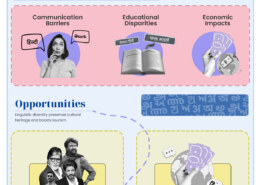What steps does the Indian education system take to overcome the obstacles that come with cultural diversity?
Hindi has made significant strides in becoming a link language in India, but its success is nuanced. As the most spoken language in the country, it serves as a common means of communication across various regions, helping bridge linguistic divides. Its use in government, media, and education reinforRead more
Hindi has made significant strides in becoming a link language in India, but its success is nuanced. As the most spoken language in the country, it serves as a common means of communication across various regions, helping bridge linguistic divides. Its use in government, media, and education reinforces its role as a unifying language.
However, India’s linguistic diversity means that not all regions view Hindi as equally central. In states like Tamil Nadu, Karnataka, and West Bengal, regional languages hold strong cultural and political significance, and there can be resistance to Hindi imposition. Efforts to promote Hindi as a national language sometimes face criticism for marginalizing regional languages and cultures.
Thus, while Hindi functions effectively as a link language in many contexts, its role is complex and can be contentious. The balance between promoting Hindi and respecting linguistic diversity remains an ongoing challenge in fostering national unity without diminishing regional identities.
See less

The Indian education system faces significant challenges due to the country's vast cultural diversity, including variations in language, religion, and socio-economic status. Here’s an overview of how the education system addresses these challenges: 1. Multilingual Education Mother Tongue InstructionRead more
The Indian education system faces significant challenges due to the country’s vast cultural diversity, including variations in language, religion, and socio-economic status. Here’s an overview of how the education system addresses these challenges:
1. Multilingual Education
2. Inclusive Curriculum
3. Focus on Social Justice
4. Civic Education and Values
5. Teacher Training and Professional Development
6. Community Engagement
7. Challenges and Limitations
Despite these efforts, significant challenges remain:
Conclusion
The Indian education system is making strides to address the challenges posed by cultural diversity through multilingual education, inclusive curricula, and social justice initiatives. While progress is evident, ongoing efforts are necessary to ensure that all students receive equitable and quality education, fostering a truly inclusive society.
See less